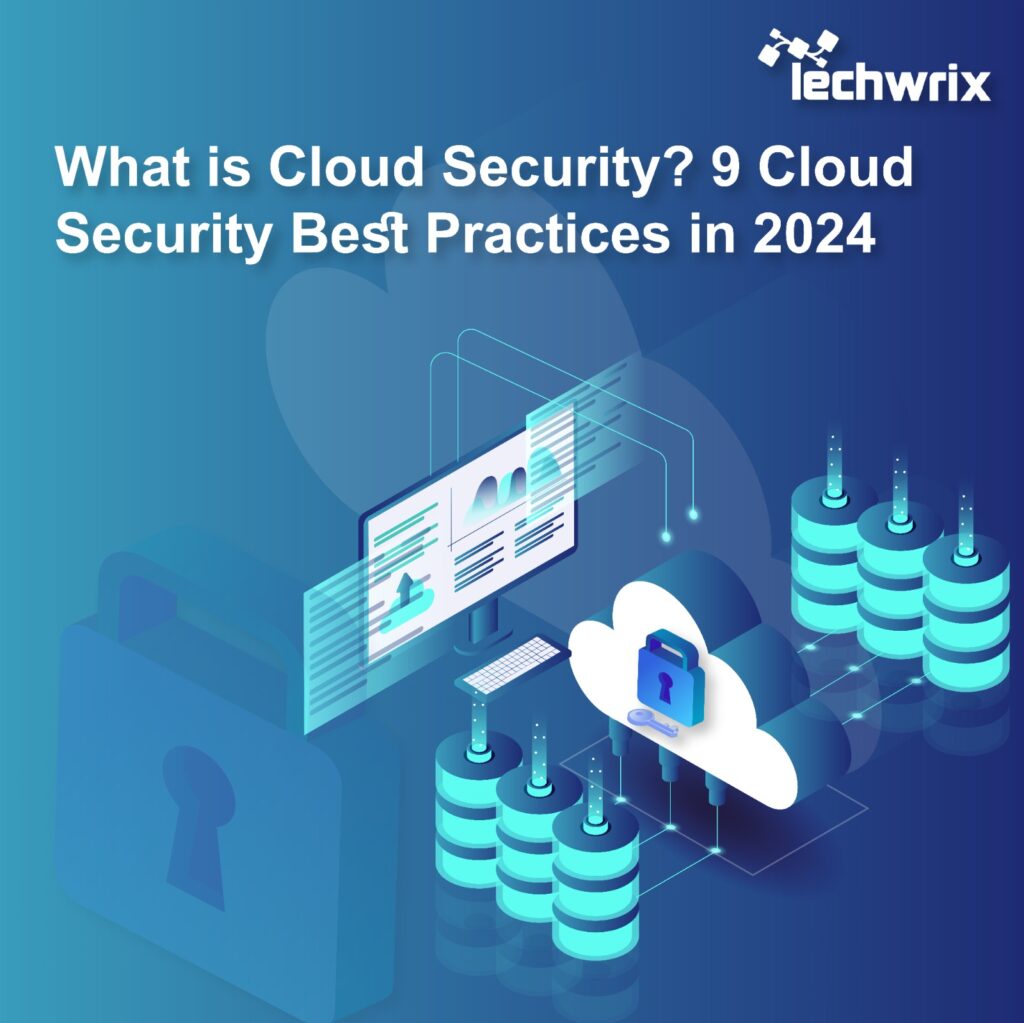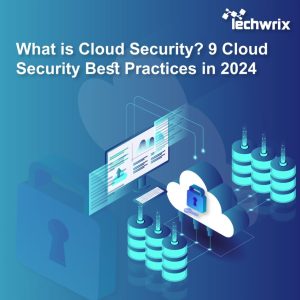What is Cloud Security? 9 Cloud Security Best Practices in 2024

Today, most people use cloud computing. And why’s that? Because it is convenient, scalable, and cost-effective. However, when there’s a good side of something, there’s a bad one too. That’s the same for cloud computing. It raises important questions like how protected is the data from hackers? What security measures are in place? And so on.
These are not just technical questions. These are actual problems that people face everyday. While the cloud has tons of benefits, it also brings specific security challenges. These challenges include data breaches, compliance issues, and more.
In 2023 a research was conducted which showed that over 8.2 Billion data records were leaked because of data breaches. So, now you know why cloud security is absolutely necessary in 2024.
Here, we’ll help you clear up your concept about cloud security and address any concerns that you have about it. This article also includes practical tips on how to keep your data safe. So, let’s dive in.
What is Cloud Security?
Cloud security is all about protecting the data, applications, and services anyone stores in the cloud. As more businesses and individuals use cloud computing, keeping this information safe becomes even more important. But what exactly does cloud security involve?
Think of cloud security as a set of practices and technologies designed to defend your cloud-based resources from various threats. These threats can include hackers trying to steal your data, viruses that can corrupt your files, and even accidental leaks of sensitive information.
One key part of cloud security is making sure only authorized people can access your data. This is done through strong passwords, multi-factor authentication, and permissions settings that control who can see and do what with your information.
Also Read: What is an Insider Threat? Definition, Types, and Prevention
What Cloud Security Covers?
Here’s a list of things that come under cloud security:
Physical Networks: This includes routers, electrical power, cabling, and climate controls. It is important to keep these components secure as they are the foundation of cloud security.
Data Storage: Cloud security makes sure that your data is protected by every means possible. Keeping the data safe is crucial to prevent unauthorized access and data loss.
Data Servers: These are the core network computing hardware and software. If your cloud servers are secure, you’ll have a smooth and safe operation of your cloud services.
Computer Virtualization Frameworks: This involves the software that creates virtual machines, as well as the host and guest machines. The security measures are crucial here to prevent breaches in virtual environments.
Operating Systems (OS): These are the software that runs on your machines, hosting all other software and applications. If you want to prevent malware, this is where you focus more for additional security.
Runtime Environments: This involves the execution and maintenance of running programs. You need to ensure these environments are secure to help prevent disruptions and attacks during program execution.
Applications: These include traditional software services such as email, tax software, and productivity suites. All of these must be kept secure to prevent data breaches and ensure safe usage.
End-User Hardware: Lastly, the hardware used by individuals such as computers, mobile devices, and Internet of Things (IoT) devices also have cloud storage. This means it is essential to protect these devices as well to cover up any potential entry points for cyber threats.
Common Cloud Security Challenges
While cloud security can simplify security management and enhance visibility, it also brings about several challenges. These include:
Identity and Access Control
Cloud providers are constantly expanding their services, resulting in an average of over 5,000 distinct entitlements per service. Managing this volume with traditional identity and access management (IAM) approaches can be overwhelming and complex.
Logging, Monitoring, and Incident Response
Effective incident response relies on comprehensive and accurate logs. Many organizations struggle to handle the large volume of data generated by cloud computing. Due to this companies usually feel their existing solutions are inadequate for collecting reliable logs, which is actually true.
Storage and Encryption
Queueing and notification services often temporarily store sensitive information before security measures can be applied. This step is frequently overlooked, and many services lack essential server-side encryption, which means the data being transferred is left vulnerable.
Cloud Ransomware
Cloud environments are most susceptible to cyberattacks because they are hosted online. Attackers typically exploit misconfigurations or weak security practices, such as excessive permissions or weak passwords to infiltrate these environments.
Supply Chain Attacks in the Cloud
Sharing data and access with third parties, like suppliers and contractors, increases the risk of supply chain attacks. This makes it crucial for security teams to prioritize the monitoring and management of third-party access to protect cloud environments effectively.
9 Cloud Security Best Practices in 2024
Here are the 9 best practices for cloud security which you might have been waiting for to read.
#1. Understand Your Shared Responsibility Model
Firstly, it is important to clearly define which security tasks are managed by your cloud provider and which tasks are to be handled by you. This understanding will help you implement effective security measures for your data, applications, and configurations.
Having well-defined roles ensures that all aspects of cloud security are covered. It also reduces the risk of security breaches due to overlooked responsibilities.
#2. Ask Detailed Security Questions
You need to ask all the right questions. Make sure to regularly check in with your cloud provider and update yourself about their security protocols, disaster recovery plans, and compliance measures. This ensures their security processes align with your organization’s requirements and helps identify any potential weaknesses in their system.
Asking these questions provides clarity on the provider’s capabilities and readiness to handle security incidents, enabling you to make informed decisions about your cloud security strategy.
#3. Train Your Staff
Employees are the backbone for any company that wants to do well in the market. So, it is important to provide comprehensive cybersecurity training to all employees. Educate them on identifying threats, using strong passwords, recognizing phishing attacks, and understanding the importance of following security policies.
Well-trained staff are essential for maintaining a secure cloud environment, as human error is a common cause of security breaches. Continuous training keeps employees updated on the latest threats and best practices.
#4. Establish and Enforce Cloud Security Policies
Now, you need to have clear cloud security policies outlining who can use cloud services, how they should be used, and what data can be stored. Also, ensure all employees adhere to these guidelines to maintain consistent security practices across the organization.
Effective policies reduce the risk of data breaches and unauthorized access by providing clear instructions and standards for handling cloud resources securely.
#5. Integrate Additional Cloud Security Tools
You can’t manually strengthen your cloud security. For that you need to use additional tools like Identity and Access Management (IAM), Intrusion Detection and Prevention Systems (IDPS), and Cloud Access Security Brokers (CASB). These tools will help enhance your security posture and defend against various threats.
These tools provide additional layers of protection by managing access, detecting malicious activities, and enforcing security policies. Which means they are more than capable of strengthening your cloud environment’s overall security framework.
#6. Conduct Penetration Testing and Audits
Now, if you want to check how strong your defenses are you’ll need to perform penetration testing and security audits on a regular basis. This proactive approach helps strengthen your defenses and ensures your security measures are effective.
Penetration testing simulates cyberattacks to find weaknesses, while audits evaluate your overall security posture. Both of these provide insights and action plans to mitigate risks and enhance protection.
#7. Enable and Monitor Security Logs
It is critical to have a detailed log of all the activities happening on the cloud environment. By doing so, you can quickly detect any security issues and respond to them before anything bad happens.
Effective logging and monitoring provides visibility into your cloud operations. It also enables you to identify anomalies, track user actions, and ensure compliance with security policies.
#8. Understand and Mitigate Misconfigurations
One of the most necessary practices to improve cloud security is to regularly review and correct configuration settings in your cloud environment. Misconfigurations can create vulnerabilities that attackers can exploit, so make sure your system configurations are on-point.
Automated tools can help detect and fix misconfigurations. They assist in reducing the risk of human error and enhancing the security of your cloud infrastructure by maintaining optimal configuration standards.
#9. Manage Unnecessary and Unauthorized Access
Last but not the least, implement strict access controls and regularly review user permissions. When you limit the access to only those who need it, it reduces the risk of unauthorized access to sensitive data.
Access management includes using role-based access control (RBAC) and the principle of least privilege. This ensures that users have the minimum necessary permissions to perform their tasks, thereby minimizing security risks.
Also Read: How to Implement AI-Powered Fraud Detection in Financial Services
Conclusion
It is important to secure your cloud environment to keep your data safe and maintain trust. When you understand your responsibilities, ask all the right questions, train your staff, and use effective security tools, you can reduce any potential risks and keep your information safe. If you don’t know how to keep your cloud security top-notch, just read the best practices again and you’ll know what to do.



